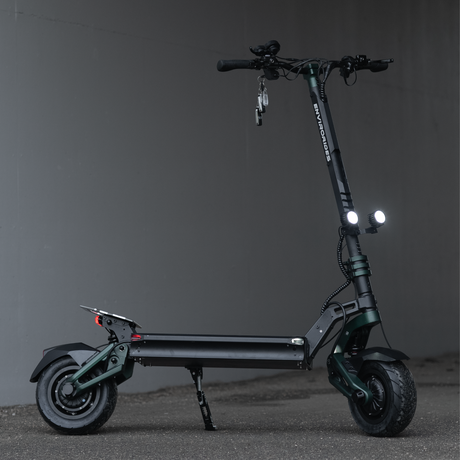It’s no joke that eBikes have truly taken a storm in today's modern society. Becoming a powerful use of transportation and an environmentally friendly one at that. But, the average Joe may lack the knowledge in terms of the technical side of things, leaving questions about what they need to know about an eBike battery and the safety measures involved. This article provides those informational goodies you seek.

Tech time! What's Inside An eBike Battery?
eBike battery packs consist of rechargeable cells, where a lithium compound or electrolyte is positioned between the anode and the cathode. The electrolyte facilitates the movement of electrons or ions from the charging port (anode) to the cathode, enabling the flow of electrical energy within the battery.
eBike batteries also have a Battery Management System (BMS). This is in an electric bike which is a crucial component responsible for monitoring, controlling, and protecting the battery pack. Electric bikes typically use lithium-ion or lithium-polymer batteries, and the BMS ensures the safe and efficient operation of these batteries throughout their lifespan.
You’re probably thinking, “Great! The battery has its own component to manage the battery pack which means less work for me!”. But, it is important to understand how to look after your eBike battery pack as it is ultimately up to you to ensure the uttermost safe practices when charging and looking after your eBike battery pack. Any form of neglect towards your battery pack could result in fatal consequences, such as the battery pack overheating and exploding thus creating a fire that could result in a potential house fire or any form of fire that is. In order to ensure, this isn’t the case, we have put together a comprehensive list of essential tips when looking after an eBike battery pack that you will find very helpful.
eBike Battery Safety: Essential Tips for Proper Usage and Maintenance
1. Charging your eBike Battery

- Use the Original Charger: Always use the charger provided by the eBike manufacturer to charge your battery. Using third-party chargers may cause compatibility issues and potential safety risks.
- Follow Charging Guidelines: Adhere to the charging guidelines provided by the manufacturer. Avoid overcharging or discharging the battery to extremely low levels.
- Charge in a Safe Location: Always charge the battery in a safe location away from flammable materials or sources of heat.
- Unplug After Charging: Once the battery is fully charged, unplug it from the charger promptly to prevent overcharging.
- Charge in a Well-Ventilated Area: When charging the battery indoors, ensure you do so in a well-ventilated area to dissipate any heat generated during the charging process.
2. Storing your eBike Battery

- Avoid Extreme Temperatures: Keep the battery away from extreme temperatures, both hot and cold, as they can adversely affect its performance and safety. Aim to store and charge the battery in a temperature-controlled environment.
- Store at Optimal Charge Level: For long periods of storage (e.g., during winter months), store the battery at around 40%-60% charge level, as this is considered the ideal range for battery longevity.
3. Buying an eBike Battery

- Purchase from a Reputable Brand: Invest in your eBike and battery pack from a trusted and reliable manufacturer to ensure quality and safety. We offer a range of eBike batteries for our eBikes.
4. Damage and Disposal of your eBike Battery

- Regularly Inspect for Damage: Regularly inspect the battery pack for any signs of damage, wear, or corrosion. If you notice anything unusual, consult an authorised dealer or a professional technician for evaluation.
- Don't Disassemble: Never attempt to disassemble the battery pack yourself. If there is a problem, seek assistance from a professional technician or an authorized dealer.
- Don't Overcharge or Overdischarge: Avoid overcharging or discharging the battery beyond the recommended levels, as it can impact battery performance and safety.
- Don't Subject to Extreme Physical Stress: Refrain from subjecting the battery to excessive physical stress or impacts, such as dropping or hitting it, as it can lead to internal damage.
- Dispose of Responsibly: If the battery reaches the end of its lifespan, follow proper disposal guidelines and recycle it in an environmentally-friendly manner.
5. General Usage and Maintenance

- Transport with Care: When transporting your eBike, remove the battery and place it in a secure and cushioned container to protect it from potential impacts.
- Keep Away from Children and Pets: Ensure that the battery is stored out of reach of children and pets to avoid accidental mishandling.
- Maintain Recommended Voltage: For long-term storage, maintain the battery at the recommended voltage level to preserve its health.
- Regularly Clean and Inspect Contacts: Keep the battery contacts and connectors clean and free from dirt, debris, or corrosion. Inspect them regularly and clean them if necessary to maintain proper electrical connections.
- Use Protective Covers: Consider using protective covers or cases for your battery pack to shield it from potential scratches, dents, or impacts during regular use.
- Follow Manufacturer Guidelines: Always adhere to the manufacturer's guidelines, instructions, and safety precautions specific to your eBike and battery pack.
It might be helpful to know that some eBike brands offer a battery check to look at the health of your battery. Our eBike company provides a battery health check also where our technical team can give you a report on the health of your battery and the steps you should take afterwards. We recommend carrying one out every 6-12 months.
What Safety Labels Must An eBike Battery Have?
Below you will find a list of what must be included when inspecting an eBike safety label. It is essential to read your safety label and to know for several reasons. Firstly, it is for user safety, the labels provide information about potential hazards and risks when using an eBike Battery.
Secondly, it informs the user of the correct standard when handling an eBike Battery and its usage. Thirdly, it explains how to avoid damaging the battery. Fourth, it clarifies the user on the legal compliance they must take when abiding by the safety regulations and standards an eBike battery must meet, this is dependent on the region you live in.
Next, it describes the environmental responsibility to encourage users to take on environmental practices to prevent hazardous materials from being discarded incorrectly. Additionally, it advises you on the warranty and support you’re entitled to However, you must follow the safety instructions it provides to make sure you do not void that warranty.
Furthermore, it provides a visual aid in terms of identifying whether the eBike battery is counterfeit or not. Lastly, it plays a role in educating you and raising awareness in terms of the potential risks with eBike batteries.
- Battery Warning Label: This label should include a warning message about the potential hazards of mishandling or misuse of the battery, such as fire, explosion, or electric shock.
- Battery Voltage and Capacity: The label should clearly indicate the battery's voltage and capacity in volts (V) and ampere-hours (Ah) or watt-hours (Wh). This information is crucial for proper charging, usage, and compatibility with the eBike system.
- Manufacturer Information: The label should include the name and contact information of the manufacturer or distributor. This allows consumers to reach out for support or inquiries related to the battery.
- Chemistry Type: The type of battery chemistry used in the eBike battery should be specified on the label (e.g., lithium-ion, lithium-polymer). Different battery chemistries have unique characteristics and require specific handling and charging procedures.
- Operating Temperature Range: The label should indicate the acceptable operating temperature range for the battery. Extreme temperatures can affect battery performance and safety.
- Recycling Information: A recycling symbol or information on proper disposal and recycling procedures should be provided to encourage environmentally responsible practices.
- Charging Instructions: The label should include guidelines for charging the eBike battery safely, such as using the recommended charger, not overcharging, and avoiding exposure to moisture during charging.
- Storage Recommendations: Instructions on how to store the battery safely when not in use, including avoiding extreme temperatures and keeping the battery away from flammable materials.
- CE or Other Compliance Marks: Depending on the region, the battery may need to comply with specific safety standards. The battery should display the relevant compliance marks, such as CE (European Conformity) or others required by local regulations.
- UN/DOT Number (For Some Batteries): Certain types of eBike batteries, such as those classified as hazardous materials for shipping, may require a UN/DOT (United Nations/Department of Transportation) number for identification during transportation.
It is to be noted, however, that the above list is not exhaustive and certain safety labels have requirements that could vary based on the eBike battery’s design, region, and applicable regulations. Please always refer to the label that’s provided on your eBike battery also the manufacturer's guidelines and consult local authorities or experts to ensure compliance with the latest safety standards for eBike batteries.
To conclude, make sure to follow the recommended guidelines provided by the safety label on your eBike battery pack. Ensure maximum safety by following our tips when looking after your eBike battery. Please ensure, you take this information into account as your safety and the safety of those around you are also important.
Frequently asked questions
Are lithium batteries in eBikes Safe?
Lithium batteries used in eBikes are generally considered safe when designed, manufactured, and used correctly. Their high energy density makes them a popular choice for eBikes, providing extended range and performance.
How safe are eBike batteries?
Electric bike batteries undergo rigorous testing and certification to meet safety standards and regulations. Reputable manufacturers adhere to strict quality control measures to ensure their batteries are safe for consumers. Regular maintenance and following the manufacturer's instructions for charging and storage also contribute to safe usage.
Do Lithium-Ion Batteries in eBikes and other devices pose fire risks?
Lithium-ion batteries, including those used in eBikes and other devices, do pose some fire risks, albeit relatively low if handled properly. The main reasons for potential fire incidents include physical damage, overcharging, and exposure to high temperatures.
- Physical Damage: Severe impact, such as from a crash or being dropped, can damage the battery's internal components, leading to thermal runaway and potentially a fire.
- Overcharging: Charging a lithium-ion battery beyond its recommended voltage can cause the battery to overheat and become a fire hazard.
- High Temperatures: Exposure to extreme heat during charging, storage, or use can lead to battery malfunction and fire.
Are lithium-ion batteries safe?
Lithium-ion batteries have undergone significant advancements in safety features and technology. When used properly and within the manufacturer's specifications, they are generally safe for everyday use. Modern lithium-ion batteries often include safety mechanisms like thermal management systems, overcharge protection, and short-circuit safeguards to reduce risks. Also to quote, Oscar Moyo BEng Msc MINCOSE MIET, the lead systems engineer at TT Electronics says "Lithium-ion batteries are a good option for eBikes because they can store a lot of energy within a small space with an energy density of up to 100 times higher than other battery alternatives,".



